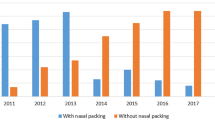Abstract
Septoplasty has been identified as suitable for day surgery, but is not commonly performed as such. Guidelines for day surgery stipulate that the unexpected re-admission rate should be 2–3 %; however previous studies have not attained this target. The purpose of this study was to ascertain the surgical and patient factors associated with re-admission following day-case septoplasty. A retrospective case-notes analysis of day-case septoplasties between 1 January 2010 and 31 December 2012 was undertaken. Data on patient demographics, surgeon grade and operative technique were examined using a univariate analysis model. A total of 256 septoplasties were performed. 23 patients were admitted, overwhelmingly due to bleeding in the immediate post-operative period, giving an overall admission rate of 9.0 % within the first 24 h. Factors associated with re-admission included the use of intranasal splints (relative risk (RR) 5.34, p < 0.001), the performance of additional operative procedures (RR 4.96, p < 0.001) and surgery on patients with co-morbidities (RR 3.37, p = 0.002). There was no correlation between unexpected admission and patient gender, age, surgeon grade, performance of revision surgery and operative factors including nasal preparation with cocaine, local anaesthetic infiltration, type of incision, number of mucoperichondrial flaps raised, extensive bony dissection, performance of a turbinate procedure, quilting, closure of incision and post-operative packing. Day-case septoplasty in patients with co-morbidities and where additional surgical procedures are performed may be associated with unexpected overnight admission. Thus, safe and efficient day-case septoplasty may not be suitable as a universal default pathway but one where case selection is key.

Similar content being viewed by others
References
Benson-Mitchell R, Kenyon G, Gatland D (1996) Septoplasty as a day-case procedure—a two centre study. J Laryngol Otol 110(2):129–131
Daabiss M (2011) American Society of Anaesthesiologists physical status classification. Indian J Anaesth 55(2):111–115
Department of Health (2000) The NHS Plan: a plan for investment, a plan for reform
Department of Health (2002) Day surgery: operational guide: waiting, booking and choice
Ganesan S, Prior AJ, Rubin JS (2000) Unexpected overnight admissions following day-case surgery: an analysis of a dedicated ENT day care unit. Ann R Coll Surg Engl 82(5):327–330
Georgalas C, Obholzer R, Martinez-Devesa P, Sandhu G (2006) Day-case septoplasty and unexpected re-admissions at a dedicated day-case unit: a 4-year audit. Ann R Coll Surg Engl 88(2):202–206
Hogg RP, Prior MJ, Johnson AP (1999) Admission rates, early readmission rates and patient acceptability of 142 cases of day case septoplasty. Clin Otolaryngol Allied Sci 24(3):213–215
Malki D, Quine SM, Pfleiderer AG (1999) Nasal splints, revisited. J Laryngol Otol 113(8):725–727
Nieminen P, Silvola J, Aust R, Stenfors LE (1997) Nasal septal surgery as an outpatient procedure. J Laryngol Otol 111(11):1034–1037
Office of Population Censuses and Surveys (1990) Tabular list of the classification of surgical operations and procedures, 4th edn
Paik YS, Renner GJ, Rice GM, Liess BD (2012) “Double-Doyle” intranasal airway splint technique. Otolaryngol Head Neck Surg 146(4):560–561
Srinivasan V, Arasaratnam RB, Jankelowitz GA (1995) Day-case septal surgery under general anaesthesia and local anaesthesia with sedation. J Laryngol Otol 109(7):614–617
The Audit Commission (2001) Acute hospital portfolio—review of national findings: day surgery
The Royal College of Surgeons of England (1992) Commission on the Provision of Surgical Services. Guidelines for day case surgery, revised edition
Verma R, Alladi R, Jackson I et al (2011) Day case and short stay surgery: 2. Anaesthesia 66:417–434
von Schoenberg M, Robinson P, Ryan R (1992) The morbidity from nasal splints in 105 patients. Clin Otolaryngol Allied Sci 17(6):528–530
Acknowledgments
The authors have no conflicts of interest to declare.
Author information
Authors and Affiliations
Corresponding author
Rights and permissions
About this article
Cite this article
Al-Hussaini, A., Walijee, H., Khan, A. et al. Day-case septoplasty: a default pathway or is case selection the key?. Eur Arch Otorhinolaryngol 272, 91–95 (2015). https://doi.org/10.1007/s00405-014-3071-x
Received:
Accepted:
Published:
Issue Date:
DOI: https://doi.org/10.1007/s00405-014-3071-x




